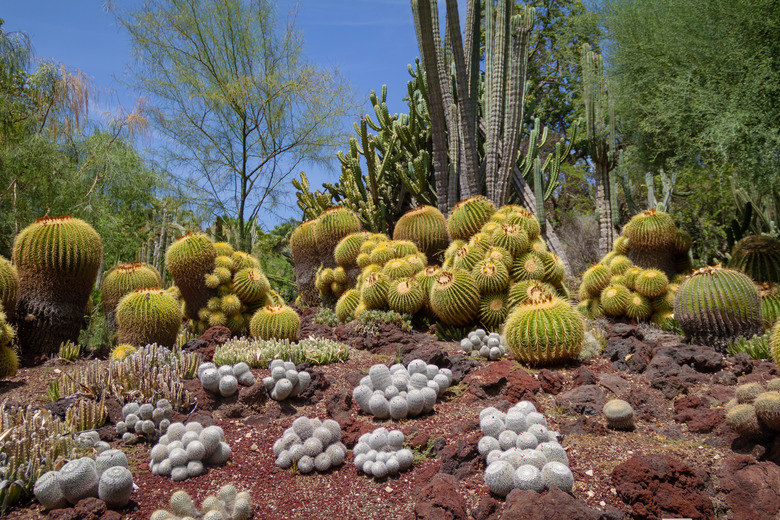How To Water A Cactus
We may receive a commission on purchases made from links.
The cactus family is primarily found in the Americas, though a few members of the genus Rhipsalis are found in Africa, Madagascar and Sri Lanka. Cacti are found in U.S. Department of Agriculture plant hardiness zones 3 through 12, depending on genus and species, so determining how to water a cactus varies depending on whether you're growing a desert or tropical cactus.
About Cactus Plants
About Cactus Plants
While most cacti are differentiated from other succulents by the bristles and spines that grow from the round areoles on their skin, not all cacti sport sharp spines. It's the cushionlike areoles that indicate a succulent is a member of the cactus family.
In the case of the brittle prickly pear (Opuntia fragilis), hardy in USDA zones 3 through 11, the thorns make it obvious that this low-growing succulent is in fact a cactus. The familiar holiday cacti, including the Christmas (Schlumbergera x buckleyi), Thanksgiving (Schlumbergera truncata) and Easter (Schlumbergera gaertneri) cacti, hardy in USDA zones 10 through 12, as well as the mistletoe cactus (Rhipsalis baccifera), hardy in USDA zones 9b through 11, have areoles and sometimes hairlike bristles but lack spines.
Whether a desert or a tropical cactus, your plant needs well-draining soil in the garden, or if it is in a flowerpot, it needs a cactus and succulent potting mix. If you make your own potting mixes, desert cacti thrive in a combination of equal parts potting mix, coarse sand and gravel or pumice, while the tropicals prefer a loose mix of two parts peat moss and one part each of all-purpose potting soil and coarse sand or perlite. Most of the tropical cacti are epiphytic and grow in the branches of trees or rock crevices, where organic matter collects and decomposes into a loose, quickly draining mix.
How to Water Desert Cacti
How to Water Desert Cacti
Spring and summer are the active growth periods for most desert cacti. Watered by the summer monsoon rains, the soil is drenched and then dried out by the sun. Wait until the soil is dry and then add water until it flows from the bottom of the flowerpot. If your cactus is growing in the garden, drench the soil with at least 1 inch of water until it is moist to a depth of at least 6 to 8 inches.
As the days grow shorter, reduce watering of your indoor cactus to once or twice a month when the soil is dry. Winter is the dormant or resting period for cacti, so don't overdo the watering. When in doubt, don't water and wait another week. In addition, no matter what time of year, remove water from the saucer under the flowerpot so that roots aren't sitting in water or wet soil.
Fertilize your indoor cactus monthly when it is actively growing with a 5-10-5 liquid fertilizer or once in spring with a slow-release cactus fertilizer. Stop fertilizing in late summer or early fall.
How to Water Tropical Cacti
How to Water Tropical Cacti
Your tropical cactus prefers an evenly moist soil, though you can allow it to dry out a little in spring and summer. Water when the soil is dry to the touch until water flows from the bottom of the flowerpot. Reduce watering after the plant blooms to once or twice a month or when the soil is dry 1 to 2 inches below the surface but don't let it completely dry out. If the fleshy leaf segments start to wrinkle or shrivel, water the plant.
Fertilize your holiday cactus monthly, beginning when new growth appears in early spring. Dilute a 20-10-20 or 20-20-20 liquid fertilizer to half strength and add until it drains from the flowerpot. Stop applying fertilizing solutions in late summer.
